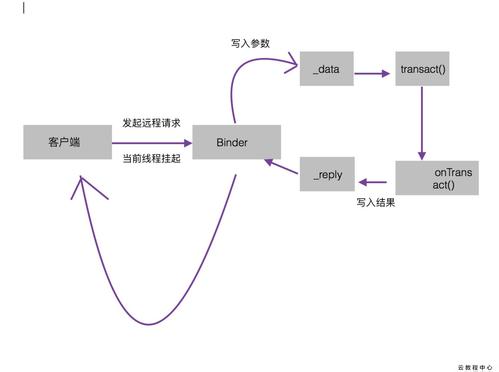进程和线程的关系
IPC机制即为跨进程通信,是inter-Process Communication的缩写。是指两个进程之间进行通信。在说进程通信之前,我们的弄明白什么是线程,什么是进程。进程和线程是两个截然不同的概念。按照操作系统中的描述,线程是CPU调度的最小单位,同时线程也是一种有限的系统资源。而进程一般是指一个执行单元,在pc端或者移动端上是指一个程序或者一个应用。一个进程中可以包含一个或者是多个线程。所以他们的关系应该是包含和被包含的关系。
跨进程的种类
在Android中跨进程通信的方式有很多种,Bundle,文件共享,AIDL,Messenger,ContentProvider,Socket,这些都能实现进程间之间的通信,当然,虽然都能够实现进程间通信,但是他们之间的实现原理或者说是底层的实现方式都是不一样的。下面,我们将会一一说明。
注:很多同学觉得创建进程就应该创建一个新的应用。其实不是的。只要我们在AndroidMenifest上加上这一句代码就可以了android:process=“:remote”具体的,同学们可以自己的了解。
在说IPC之前,先说一下一些基础概念,这样对后面的内容能够更好的理解。
1、Serializable,Parcelable接口
Serializable接口是java提供的一个序列化的接口,这是一个空的接口,为对象提供标准的序列化和反序列化操作。Serializable序列化和反序列化,都是采ObjectOutputStream 和ObjectInputStream就可以实现,当然这些系统基本已经为我们实现了。
Parcelable接口,是Android自带的一种序列化方式。序列化和反序列化都是通过writeToParcel方法来完成的。
两者的区别:Serializable是java的序列化接口使用简单,但是由于序列化和反序列化的过程需要大量的I/o操作,所以性能较差。Parcelable接口使用较为麻烦,但是效率很高,但是存在一个很大的缺点,就是被Parcelable将对象序列化以后,要将对象保存到磁盘中的,将会很麻烦。所以建议是使用Serializable。
Binder
直观来说,Binder是Android中的一个类,它实现了IBinder接口,从IPC的角度来说,Binder是Android中的一种跨进程通信的一种方式,同时还可以理解为是一种虚拟的物理设备,它的设备驱动是/dev/binder/。从Framework角度来说,Binder是ServiceManager的桥梁。从应用层来说,Binder是客户端和服务端进行通信的媒介。
在Android开发中,Binder主要用在Service中,包括AIDL和Messenger,由于Messenger的底层其实就是Aidl,所以现在我们以AIDL来分析一下binder的工作机制。
对AIDL还不懂使用的朋友可以看一下我以前写的一篇博客:http://www.cnblogs.com/huangjialin/p/7738104.html,下面就以这个例子来分析一下这个Binder的工作机制。
上代码:
1 /*
2
3 * This file is auto-generated. DO NOT MODIFY.
4
5 * Original file: /Users/huangjialin/MyApplication/service/src/main/aidl/aidl/MyAIDLService.aidl
6
7 */
8
9 package aidl;
10
11 // Declare any non-default types here with import statements
12
13
14 public interface MyAIDLService extends android.os.IInterface {
15
16
17
18 /**
19
20 * Local-side IPC implementation stub class.
21
22 */
23
24 public static abstract class Stub extends android.os.Binder implements aidl.MyAIDLService {
25
26 private static final java.lang.String DESCRIPTOR = "aidl.MyAIDLService";
27
28
29
30 /**
31
32 * Construct the stub at attach it to the interface.
33
34 */
35
36 public Stub() {
37
38 this.attachInterface(this, DESCRIPTOR);
39
40 }
41
42
43
44 /**
45
46 * Cast an IBinder object into an aidl.MyAIDLService interface,
47
48 * generating a proxy if needed.
49
50 */
51
52 public static aidl.MyAIDLService asInterface(android.os.IBinder obj) {
53
54 if ((obj == null)) {
55
56 return null;
57
58 }
59
60 android.os.IInterface iin = obj.queryLocalInterface(DESCRIPTOR);
61
62 if (((iin != null) && (iin instanceof aidl.MyAIDLService))) {
63
64 return ((aidl.MyAIDLService) iin);
65
66 }
67
68 return new aidl.MyAIDLService.Stub.Proxy(obj);
69
70 }
71
72
73
74 @Override
75
76 public android.os.IBinder asBinder() {
77
78 return this;
79
80 }
81
82
83 @Override
84
85 public boolean onTransact(int code, android.os.Parcel data, android.os.Parcel reply, int flags) throws android.os.RemoteException {
86
87 switch (code) {
88
89 case INTERFACE_TRANSACTION: {
90
91 reply.writeString(DESCRIPTOR);
92
93 return true;
94
95 }
96
97 case TRANSACTION_getString: {
98
99 data.enforceInterface(DESCRIPTOR);
100
101 java.lang.String _result = this.getString();
102
103 reply.writeNoException();
104
105 reply.writeString(_result);
106
107 return true;
108
109 }
110
111 }
112
113 return super.onTransact(code, data, reply, flags);
114
115 }
116
117
118
119 private static class Proxy implements aidl.MyAIDLService {
120
121 private android.os.IBinder mRemote;
122
123
124
125 Proxy(android.os.IBinder remote) {
126
127 mRemote = remote;
128
129 }
130
131
132
133 @Override
134
135 public android.os.IBinder asBinder() {
136
137 return mRemote;
138
139 }
140
141
142
143 public java.lang.String getInterfaceDescriptor() {
144
145 return DESCRIPTOR;
146
147 }
148
149
150
151
152 @Override
153
154 public java.lang.String getString() throws android.os.RemoteException {
155
156 android.os.Parcel _data = android.os.Parcel.obtain();
157
158 android.os.Parcel _reply = android.os.Parcel.obtain();
159
160 java.lang.String _result;
161
162 try {
163
164 _data.writeInterfaceToken(DESCRIPTOR);
165
166 mRemote.transact(Stub.TRANSACTION_getString, _data, _reply, 0);
167
168 _reply.readException();
169
170 _result = _reply.readString();
171
172 } finally {
173
174 _reply.recycle();
175
176 _data.recycle();
177
178 }
179
180 return _result;
181
182 }
183
184 }
185
186
187
188 static final int TRANSACTION_getString = (android.os.IBinder.FIRST_CALL_TRANSACTION + 0);
189
190 }
191
192
193
194 public java.lang.String getString() throws android.os.RemoteException;
195
196 }
197
198
上面这段代码是系统生成的,在gen目录下可以看到根据MyAIDLService.aidl系统为我们生成了MyAIDLService.java这个类。我们先来了解一下这个类中每个方法的含义:
DESCRIPTOR:Binder的唯一标识,一般用于当前Binder的类名表示。
asInterface(android.os.IBinder obj):用于将服务端的Binder对象转换成客户端所需的AIDL接口类型的对象,这种转化过程是区分进程的,如果客户端和服务端位于同一个进程,那么这个方法返回的是服务端的stub对象本身,否则返回的是系统封装后的Stub.proxy对象。
asBinder():用于返回当前Binder对象。
onTransact:该方法运行在服务端的Binder线程池中,当客户端发起跨进程通信请求的时候,远程请求通过系统底层封装后交给该方法处理。注意这个方法public boolean onTransact(int code, android.os.Parcel data, android.os.Parcel reply, int flags),服务端通过code可以确定客户端所请求的目标方法是什么,接着从data中取出目标方法所需的参数,然后执行目标方法。当目标方法执行完毕后,就像reply中写入返回值。这个方法的执行过程就是这样的。如果这个方法返回false,客户端是会请求失败的,所以我们可以在这个方法中做一些安全验证。
public java.lang.String getString() throws android.os.RemoteException:
这个方法运行在客户端中,当客户端调用此方法的时候,它的内部实现是这样的:首先创建该方法所需要的输入类型Parcel对象_data,然后调用transact方法发起远程调用请求,同时当前线程挂起,然后服务端的OnTransact方法会被调用,直到RPC过程返回后,当前线程继续执行,并从_reply中读取返回的数据。
如图:Binder的工作机制

从上面分析,我们明白了Binder的工作机制但是要注意一些问题:1、当客户端发起请求时,由于当前线程会被挂起,直到服务端返回数据,如果这个远程方法很耗时的话,那么是不能够在UI线程,也就是主线程中发起这个远程请求的。
2、由于Service的Binder方法运行在线程池中,所以Binder方法不管是耗时还是不耗时都应该采用同步的方式,因为它已经运行在一个线程中了。
来源:oschina
链接:https://my.oschina.net/u/4316924/blog/4051297